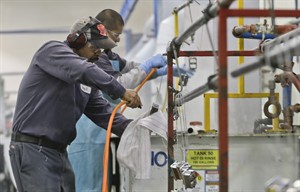
Survey: US manufacturing expands in October at fastest pace in 2 1/2 years, despite shutdown
WASHINGTON – U.S. factory activity expanded in October at the fastest pace in 2 1/2 years, suggesting businesses kept spending last month despite the partial government shutdown.
The Institute for Supply Management, a trade group of purchasing managers, said Friday that its manufacturing index rose in October to 56.4. That’s up from 56.2 in September. A reading above 50 indicates growth.
Manufacturing has increased at a faster pace for five straight months, according to the index. In October, a measure of new orders rose slightly, while a gauge of production fell but remained at a high level. Factories added jobs, though at a slower pace than the previous month.
A measure of export orders jumped to its highest level in nearly a year and a half, a sign of improving economies overseas.
Manufacturing has shown some signs of acceleration in recent months and activity grew in October, even though the 16-day shutdown held back orders at many factories that do business with the government. Factories benefited from healthier growth overseas and a robust U.S. auto industry that is having its best year since the recession began.
Car sales have soared this year and overseas growth in Japan and Europe has picked up a bit.
China’s economy has also picked up after slowing earlier this year. A measure of manufacturing in China, released Friday, showed its best improvement in seven months.
Still, the shutdown slowed activity at companies that make metal products and electrical equipment, according to the ISM survey. And the more positive results in the survey are at odds with other manufacturing data.
Factories barely increased their output in September, the Federal Reserve said on Monday. Automakers produced more, but that gain was offset by declines at companies that make computers, furniture and appliances.
Companies reduced demand for long-lasting factory goods in September, the Commerce Department said last week. Orders for industrial machinery, electrical equipment and other core capital goods fell 1.1 per cent. August’s orders were revised down to a 0.4 per cent gain, from 1.5 per cent.
Economists pay particular attention to core capital goods, which exclude aircraft and defence-related goods, because they reflect business confidence.
Analysts were encouraged by a survey of companies in the Chicago region, released Thursday, that found they expanded at the fastest pace in more than two years in October. New orders jumped and hiring also rose.
Still, economists don’t expect manufacturing to boost economic growth in the coming months. Growth likely fell to an annual rate of just 1.5 per cent to 2 per cent in the July-September quarter, down from a 2.5 per cent pace in the April-June period. Most economists expect similarly slow growth in the final three months of the year.
Join the Conversation!
Want to share your thoughts, add context, or connect with others in your community? Create a free account to comment on stories, ask questions, and join meaningful discussions on our new site.












Leave a Reply
You must be logged in to post a comment.